Getting to explore with your pet in Yosemite and other national parks can be a memorable family experience, especially when you plan ahead and understand what’s possible. Group photos at Tunnel View? Go for it! Hiking the Mist Trail to Nevada Fall? Someone from your group will need to stay behind with the pet.
As Yosemite National Park’s nonprofit park partner, Yosemite Conservancy supports national park staff’s work with the B.A.R.K. Ranger initiative to protect habitats, wildlife, and your visitor experience by providing information and resources.
This guide to Yosemite National Park is here to be your resource so that you and your pet have the best experience possible while supporting the park and all of its cultural and natural resources.
What is a B.A.R.K. Ranger? A B.A.R.K. Ranger can be any pet that you bring to Yosemite National Park who follows the B.A.R.K. Ranger code. While most B.A.R.K. Rangers are canines, we strive to be inclusive of all pets.
Please note: this blog is intended for pets and NOT stock animals, such as horses and mules, or service animals.
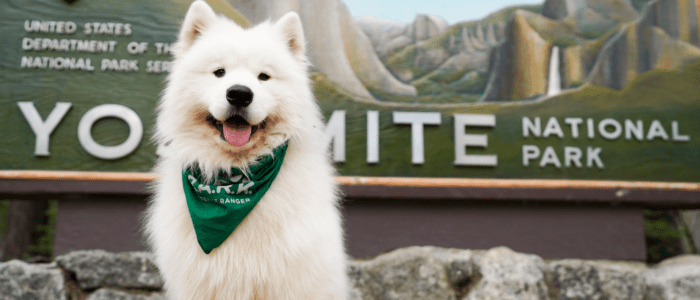
Olaf the Samoyed smiling in front of the Yosemite National Park sign located outside the Big Oak Flat entrance on highway 120.
What does B.A.R.K. Ranger code stand mean for a pet in Yosemite?
Bag your pet’s waste: By bagging and disposing of your pet’s waste properly you help keep Yosemite clean and its wildlife safe.
How does this help? First, by bagging your pet’s waste it helps prevent another hiker from stepping into it! Also, by bagging waste, it prevents the spread of bacteria and illnesses between pets and wildlife.
Always leash your pet: Pets at all times must be leashed. Leashes may be up to 6 feet long.
How does this help? Yosemite is a popular place and keeping your pet on leash at all times helps to ensure a positive experience for all visitors. It also helps prevent your pet from getting too close to wildlife.
Respect wildlife: Always stay at least 50 yards away from bears and 25 yards from other wildlife (off sizes) that you may encounter on your visit. Make sure your pet stays on trail.
How does this help? Beyond the protection of larger wildlife such as deer and bears, there are many nesting birds and rodents hiding in meadow grasses that are important to Yosemite’s ecosystems.
Know before you go: Plan ahead before coming to the park. See the FAQ section below for more details on where your pet can and cannot go in the park.
How does this help? This helps you have the best experience possible by allowing you to plan accordingly and not be disappointed when your pet can’t hike the Mist Trail with you.
To learn about how each of these rules helps keep your pet, wildlife, and Yosemite National Park safe visit Yosemite National Park’s B.A.R.K. Ranger webpage.
By following the B.A.R.K. Ranger code of conduct, you and your pet help to model the behaviors that will ensure a positive visitor experience for everyone in Yosemite while protecting the park’s natural and cultural history.
You can celebrate your B.A.R.K. Ranger by purchasing B.A.R.K. Ranger swag from the Conservancy gift shop in park or online.
Frequently Asked Questions about Pets in Yosemite
Below is a quick FAQ to help you help your pet be the best B.A.R.K. Ranger they can be!
Q: Where can I take my pet in Yosemite?
A: Many places! Here are three basic areas to keep in mind:
- All developed areas, but NOT inside public buildings.
- This includes inside visitor centers, restrooms, restaurants etc.
- On fully paved roads, sidewalks, and bicycle paths except when signed as not allowing pets.
- In all campgrounds except walk-in campgrounds (e.g., Camp 4 and backpackers camps) and in group campsites. Please note: when staying in a campground that pet food and other scented items needs to be stored securely in the same way that all of your food and scented items are stored.
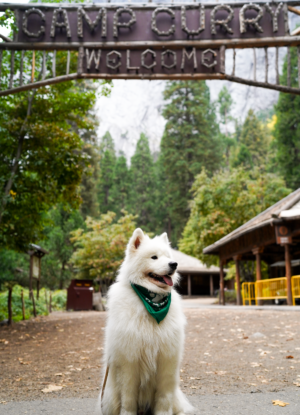
Camp Curry has lots of outside seating at its eateries. Perfect for people with their pet in Yosemite to share a meal together.
Q: Are there any restaurants with outdoor seating?
A: Yes, there are many restaurants in Yosemite Valley with outdoor seating available.
- Pizza Deck (open seasonally)
- Degnan’s Kitchen (open year round)
- Village Grill Deck (open seasonally)
- Mountain Room Lounge (open year round)
- Basecamp Eatery (open year round; seating available in around outdoor amphitheater)
Outside Yosemite Valley
- Tuolumne Meadows Grill (open seasonally)
For the current dining option availability and hours see the Travel Yosemite website.
You can also purchase grab and go options from stores in Yosemite Valley, such as the Village Store, or pack food from home and eat at a picnic area in the park.
Q: What does this mean if I want to take a picture at scenic vista? Does that count as a “developed area”?
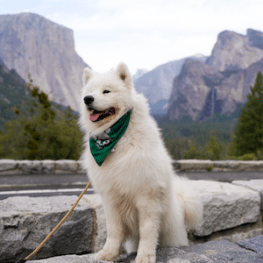
Olaf smiling at Tunnel View showing off great places to get pictures of your pet in Yosemite.
A: Scenic vista areas such as Tunnel View, Valley View, Glacier Point, and Olmsted Point are okay to bring your pet.
Remember the B.A.R.K. Ranger code, explained above, is expected at all times in the park and your pet should not explore the area beyond the developed walkways and overlooks. This means leashes should stay on, even for overlook photo shoots.
If you plan on sharing your photos on social media tag Yosemite Conservancy, we’d love to see your B.A.R.K. Ranger out and about in Yosemite.
Q: Is there anywhere my pet cannot go?
A: There are several areas that pets are not allowed in Yosemite, even on a leash. By not entering these prohibited areas you are helping protect wilderness and wildlife and provide a positive visitor experience for everyone who comes to Yosemite:
- On unpaved trails
- The trail to Vernal Fall
- On unplowed roads covered in snow
- In undeveloped and wilderness areas
- In public buildings
- On shuttle buses
- In lodging areas
- In all walk-in and group campgrounds/campsites, including Camp 4
- O’Shaughnessy Dam at Hetch Hetchy
- In any other areas, as signed
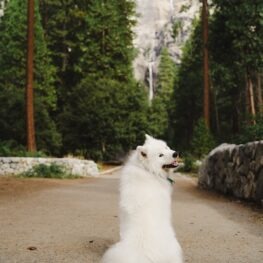
Olaf is ready to hike Lower Yosemite Fall.
Q: Wow, so where can I take my pet for a walk in Yosemite?
A: Great question! Exploring the beauty of Yosemite National Park is a wonderful activity with your pet. We’ve listed pet-appropriate hikes organized by location in the park.
Yosemite Valley
- Lower Yosemite Fall: This 1 mile easy loop offers spectacular views of Yosemite Falls. The eastern portion of this loop trail is wheelchair accessible. This trail also begins at Shuttle Stop #6
- Cook’s Meadow: This 1 mile flat loop offers wonderful views of Yosemite Falls, Half Dome, and Sentinel Rock. It is located across the street from the Shuttle Stop #6 (Lower Yosemite Fall).
- Paved bike and pedestrian paths: Sharing the paved pathways with cyclists, opens up over 12 miles of walkways from Swinging Bridge all the way to Mirror Lake.
- Mirror Lake *Paved Bike Path: The 2 mile out and back leads to stunning views of Half Dome. Begins at Shuttle Stop #17. Remember only the paved bike path portion of this hike is appropriate for pets.
Outside of Yosemite Valley
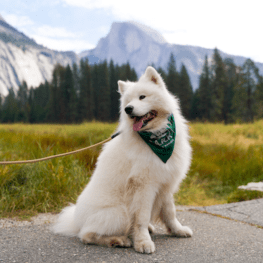
Olaf is showing off the beautiful paved pathway that leads across Cook’s Meadow.
Crane Flat Area:
Tuolumne Grove Road between Hodgdon Meadow and the Tuolumne Grove parking lot. This is actually part of the historic Big Oak Flat road that ran to Yosemite Valley.
While walking on the Tuolumne Grove Road please remember the loop through the trees is not included in this hike, just the roadway.
A round-trip hike from the parking area to Tuolumne Grove is about 3 miles.
The Tuolumne Grove Road does continue past the Tuolumne Grove of Giant Sequoia grove all the way to Hodgdon Meadow. The round trip to Hodgdon Meadow and back via Old Big Oak Flat Road is approximately 11 miles.
Important note: The Tuolumne Grove Road primarily goes downhill from the parking area to the Tuolumne Grove, which can give an enhanced sense of vitality and strength. Going back up the hill can quickly zap that joy. Packing water and snacks can help!
Wawona Area:
Wawona Meadow Loop: Across the street from the historic Wawona Hotel is the Wawona Meadow Loop. This 3.5 mile relaxing stroll follows an unpaved fire road.
Reminder: Pets are NOT allowed at the Mariposa Grove.
Looking for a longer hike in the Wawona Area? Pets are also allowed on the Chowchilla Mountain Road which begins on the same paved roadway across from the Wawona Hotel. Important caveats for hikers with pets on the Chowchilla Mountain Road:
- This is a road where you may encounter vehicles, please remain aware of your surroundings.
- The road continues for many miles and there are no services. Please pack what you and your pet will need for the entirely of the hike.
- This road is not used often, please be sure to carry maps of the area with you and be prepared to navigate accordingly.

Becoming a B.A.R.K. Ranger is a great way to celebrate bringing your pet to Yosemite.
Q: How does my pet in Yosemite become a B.A.R.K. Ranger?
A: Great question! When you and your pet feel like you understand the B.A.R.K. Ranger code you can ask any park ranger to swear in your pet as a Yosemite B.A.R.K. Ranger. You may need to help answer a few questions before being able to officially swear your pet in. Make sure to know your B – A – R – K.
Q: What’s the best time of year to bring my pet to Yosemite?
A: Any time of year. Below are some seasonal safety tips to keep in mind while planning your trip for your pet in Yosemite.
Summer Safety Tips:
Hot Paws! It is important to remember that many of the pet-appropriate pathways are paved. Pavement surfaces can get quite hot in the summer months and could hurt your pet’s paws, even a pet in Yosemite.
Avoiding walking in the heat of the day or providing booties for your pet’s paws can help keep your pet safe in the summer heat!
Friends help friends stay hydrated! Just like humans, it is important for your pet to stay hydrated in Yosemite National Park. Download the National Park App before you leave home to help you locate water refilling stations while you’re visiting the park.
Fall Safety Tips:
Fall is an important time to be extra respectful of wildlife. Bears are busy eating thousands of calories in acorns every day and deer are entering their mating season with bucks sporting full racks of antlers. Keeping your pet securely on leash and staying aware of your surroundings can help keep every creature safe.
Q: Does every national park and public land have the same rules as a pet in Yosemite?
A: Every national park, national forest, state park, and public park will have their own rules for pets. We thank you for taking the time to learn more about Yosemite’s B.A.R.K. Ranger code for your pet before your trip!
Special thanks to Olaf the Samoyed for being our featured B.A.R.K. Ranger on this blog post. You can learn more about Olaf here.
All photos of Olaf are by Eric Medina.
